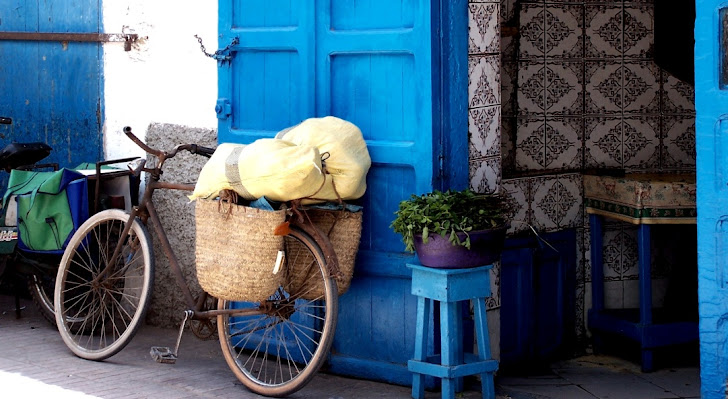
I've heard many people complaining that in Morocco one finds nothing but couscous and tagines, tagines and couscous. It is true, most of what you get in restaurants do involve one or the other, if not both. But there is more to that. Or at least the flavours can change (a bit) and in any case I love them so much that I really didn't mind!
Morocco has always been a place which has occupied a special fantastical place in my imagination (the real Thousand and One Nights). And when we eventually went, nothing disappointed me. On the contrary, everything was even better than expected. Smells, colours, noises from the market or street vendors, all mix in a grand bazaar.
I cannot deny that there are no annoyances. There are, or better, there can be. But only if you are somebody who starts talking to anyone on the street and starts following him into some remote Berbere market (because of course, everything is Berbere down there, not Arabic) and to some amazingly stinky tanneries.


So what did I cook in the end? Fish Tagine!
This dish is great because you can also prepare it in advance, then simply bang it in the oven and forget about it for at least an hour and even if you leave it there for a bit longer (once you've switched the oven off), that doesn't matter as this even intensifies the flavour.
It is very colourful so always ideal for dinner parties. And if you cook it in the actual tagine itself, you can also serve it straight to the table, removing the lid in front of your guests and expecting a "wow....uhhh".
I had a similar tagine in Essouira. I loved that place. It is so calm and peaceful with white washed houses and blue doors (that blue blows you away), a lively fish market by the port, and a constant breeze blowing over the rampants. If you are in Morocco, do make a detour down there. The impression you will have compared to Marrakesh is totally different. No hassles at shopping and no constant interest from the locals.



We stayed in this lovely guest house right on the cliffs. I had a seagull staring at me for a worrying minute, completely still in the air, while I was eating my semolina pancake (very typical for Moroccan breakfast) with honey. Surprisingly the place was called The Seagull (Dar Al Bahar). Don't leave the place without having savoured a pigeon or prawn pattie (pastilla) or eaten at a fabolous restaurant called Les Alizes' tucked away in a little alley and only lit with candles. Great atmosphere, and not just for the tourists!

Fish Tagine
For 4 people
4 fish fillets (cod or any white fish);
1 tin tomatoes;
1 onion;
2 garlic cloges;
1 tsp cinnamon;
2 tsp cayenne pepper;
2 tsp paprika;
1 tsp cumin powder (I used seeds instead and the result is the same);
3 handfuls of fresh coriander;
2 handful of fresh parsley;
3 tbsp olive oil;
juice of half juice;
4 large potatoes;
2 peppers (red and yellow if possible as it guarantees more colour)
1. In a mortar (or a in a mixer for the modern and busy Berbere dame) mix to a paste all the herbs, garlic, spices and oil. Squeeze the lemon juice and mix well. This is called chermoula.
2. Marinate the fish (cut into 4-5cm long pieces) in the marinade for at least 1 hour (you can make an express tagine and do it even in half an hour if you cook the fish in a pan using a lid to ensure that the flavour intensifies quickly and the fish absorbs it.
3. Chop the peppers and the onion.
4. Peel and slice the potatoes (if you have decided to make the express tagine, then cook the sliced potatoes in boiling and salty water to speed up the cooking time) and place them on the bottom of the tagine or a deep oven tray.
5. Place the peppers, onions, tomatoes on top of the potatoes and then the marinated fish. Cover and place in the oven (if you are using the tagine make sure that it can go into the oven as some of them might crack as they are supposed to be used only on a hob).
6. Cook the dish in the oven for at least 1 hour at 200C. Serve it with couscous which you will have cooked separately in a pan by adding to the grain 2 tsp of salt (for 300g couscous), 1 tsp turmeric, and 1 tsp cinnamon and then covering it with enough boiling water to cover it more than a finger. The coucous must absorb all the water so make sure that the lid is closed and you never peer through. You can add a knob of butter to separate the grains with a fork.
By the way, tagine is, as I am sure you know, being the well-travelled sophisticates that you are, the utensil with the conic hat in which all the ingredients get cooked rather than the dish itself. In Morocco you can find all kid of tagines - sizes, colours, patterns. A tagine for every season.

I've always loved the Yves Rocher bag.





















